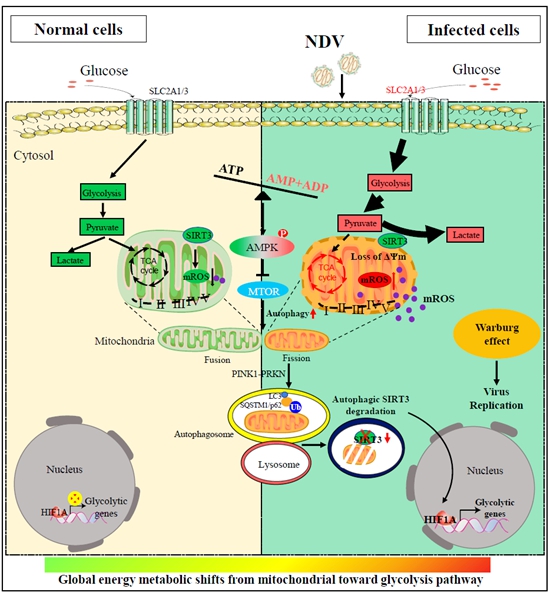SHVRI Reveals New Mechanisms by Which Newcastle Disease Virus Manipulates Host Energy Metabolism Reprogramming
Recently, the Waterfowl Viral Infectious Diseases Innovation Team of Shanghai Veterinary Research Institute (SHVRI) has found that Newcastle disease virus infection reprograms cellular metabolism pattern, and solves the problem of cell energy supply during virus infection. This paper was published online in Autophagy.
Viruses are biological entities that are non-cellular life forms. It is obligate parasites that depend on host cells to provide the energy, molecular precursors, and specialized components needed for producing infectious virions. Cellular metabolism caters to the energy and metabolite needs of cells. Newcastle disease virus (NDV) is a paramyxovirus, that is currently being developed as an oncolytic virus for cancer treatment. Mitochondria are the important bioenergetics and biosynthetic hubs with metabolic network dynamically undergoing fusion and fission. Mitophagy is a selective form of autophagy that eliminates damaged mitochondria and promotes the recycling and cellular balance of three key classes of metabolites: nucleotides, amino acids, and lipids. However, how NDV alters cellular metabolism is still far from fully understood.
In this study, authors show that NDV infection reprograms cell metabolism by increasing glucose utilization in the glycolytic pathway. In mechanism, NDV induces mitochondrial damage, elevated mitochondrial reactive oxygen species (mROS) and ETC dysfunction. Infection of cells depletes nucleotide triphosphate levels, resulting in elevated AMP:ATP ratios, AMP-activated protein kinase (AMPK) phosphorylation, and MTOR crosstalk mediated autophagy. In a time-dependent manner, NDV shifts the balance of mitochondrial dynamics from fusion to fission. Subsequently, PINK1-PRKN-dependent mitophagy was activated, forming a ubiquitin chain with MFN2 (mitofusin 2), and molecular receptor SQSTM1/p62 recognized damaged mitochondria. Authors also found that NDV infection induces NAD+-dependent deacetylase SIRT3 loss via mitophagy to engender HIF1A stabilization, leading to the switch from oxidative phosphorylation (OXPHOS) to aerobic glycolysis. Overall, these studies support a model that NDV modulates host cell metabolism through PINK1-PRKN-dependent mitophagy for degrading SIRT3.
This work provides a new perspective that virus regulates cell metabolism will enhance our understanding of how viruses hijack metabolism for selective advantages, as well as provide innovative approaches for therapeutic targeting.

This work was supported by the National Natural Science Foundation of China [32030108]; National Natural Science Foundation of China [91957120]; National Natural Science Foundation of China [32122085]; Natural Science Foundation of Shanghai [18ZR1448700].
Paper link:
https://www.tandfonline.com/eprint/JT3E8BU9B2NFCRCCB43S/full
By Gong Yabin (gongyabin2018@163.com)
-
 Apr 18, 2024Opening Ceremony of the Training Workshop on Wheat Head Scab Resistance Breeding and Pest Control in Africa Held in CAAS
Apr 18, 2024Opening Ceremony of the Training Workshop on Wheat Head Scab Resistance Breeding and Pest Control in Africa Held in CAAS -
 Apr 03, 2024IPPCAAS Co-organized the Training Workshop on Management and Application of Biopesticides in Nepal
Apr 03, 2024IPPCAAS Co-organized the Training Workshop on Management and Application of Biopesticides in Nepal -
 Mar 28, 2024Delegation from the School of Agriculture and Food Science of University College Dublin, Ireland Visit to IAS, CAAS
Mar 28, 2024Delegation from the School of Agriculture and Food Science of University College Dublin, Ireland Visit to IAS, CAAS -
 Mar 25, 2024Director of World Food Prize Foundation visited GSCAAS
Mar 25, 2024Director of World Food Prize Foundation visited GSCAAS -
 Mar 20, 2024Institute of Crop Sciences (ICS) and Syngenta Group Global Seeds Advance Collaborative Research in the Seed Industry
Mar 20, 2024Institute of Crop Sciences (ICS) and Syngenta Group Global Seeds Advance Collaborative Research in the Seed Industry
